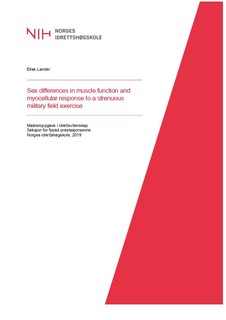| dc.description.abstract | Purpose: The purpose of this study was to investigate sex differences in the physiological and myocellular responses to a strenuous military field exercise (FEX), both acutely and in the recovery phase.
Methods: Soldiers (F=8, M=10) from the Norwegian Defense Cyber Academy conducted a 10-day strenuous FEX. Body composition was measured by bioelectrical impedance before (T1) and 0 (T2-0), 1 (T2), 7 (T3) and 14 (T4) days after the FEX, whereas as maximal leg extension force was tested at T1, T2, T3 and T4. Skeletal muscle biopsies were obtained from m. vastus lateralis at T1, T2 and T3. Biopsies were analyzed for the following proteins involved in regulation of protein balance and metabolism by western blots: 4E-BP1, p70S6K, AMPKα, Ulk1, COX-IV, HADH, CS and Na+K+β1.
Results: Lean leg mass increased with 4.4 ± 2.6 % for men and women combined at T2-0 and returned to pre values at T3, with no sex difference. Men and women combined declined in maximal leg extension force with 9.2 ± 11% at T2 (p<0.05) and was still 8.8 ± 13% reduced at T4 (p<0.05), with no sex differences. The ratio between phosphorylated and total AMPK (AMPKP/T) increased by 39 ± 40% at T2 (p<0.05) and by 48 ± 47% at T3 (p<0.001). At T3, we also report a 46 ± 49% increase in the phosphorylation of AMPKThr172 (p<0.01). We observed tendencies for sex difference in the relative change from T1 for 4E-BP1 (p=0.082) and Na+K+β1 (p=0.065) at T2 and in p70S6K (p=0.057) at T3. At T2, there were a significant different in the change in Ulk1 (p<0.05), where women decreased 22 ±15 % and men increased 16 ± 17%. Na+K+β1 decreased by 7 ± 12% (p<0.05) at T2 and 12 ± 13% (p<0.05) at T3. COX-IV decreased 15 ± 43% at T2 (p<0.05), and was recovered at T3, whereas CS decreased 18 ± 21% (p<0.05) at T3. There were no significant changes in HADH.
Conclusion: A strenuous military field exercise resulted in similar reductions in maximal force for men and women together with increased catabolism and/or inhibited anabolism, which lasted for at least one week. There was a sex difference in the change in protein levels of Ulk1, but this was not related to any difference in reduction of maximal force. The results indicate that there may be sex differences in the myocellular response to a military field exercise, but further investigations are needed. | nb_NO |
